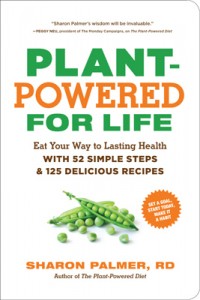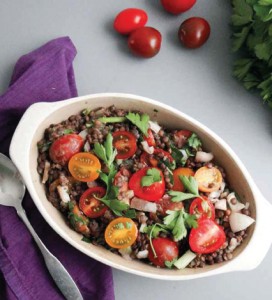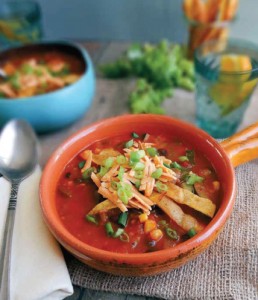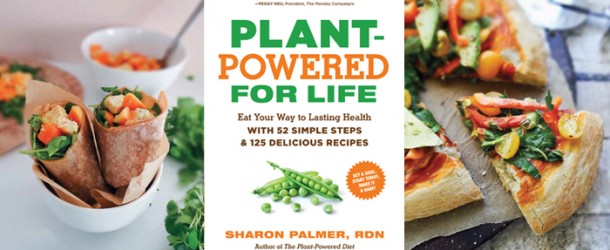 Sharon Palmer is on a mission to help you fall in love with plants. In her new book Plant-Powered for Life she conjures up images of farmers markets full of fresh, crisp vegetables, produce bins overflowing with juicy ripe fruit, and fields of fresh leafy greens. Even the most die-hard carnivore wouldn’t be able to surrender to plant-based temptation. Alongside those images of fresh produce are visions of aromatic spices, pots of freshly cooked beans, and bowls full of warm whole grains. I had just finished a rather large lunch when I settled in on the sofa with Plant-Powered for Life, which had just arrived in my mailbox from The Experiment the day before, and I wanted to jump back up, head to the kitchen, and start cooking.
Sharon Palmer is on a mission to help you fall in love with plants. In her new book Plant-Powered for Life she conjures up images of farmers markets full of fresh, crisp vegetables, produce bins overflowing with juicy ripe fruit, and fields of fresh leafy greens. Even the most die-hard carnivore wouldn’t be able to surrender to plant-based temptation. Alongside those images of fresh produce are visions of aromatic spices, pots of freshly cooked beans, and bowls full of warm whole grains. I had just finished a rather large lunch when I settled in on the sofa with Plant-Powered for Life, which had just arrived in my mailbox from The Experiment the day before, and I wanted to jump back up, head to the kitchen, and start cooking.
 Plant-Powered for Life is a health and recipe book in one, but it’s not your typical health or recipe book. Most books on vegan health are full of scientific facts and (some might say) rather boring data, with recipes tucked in at the back of the book. And there are those vegan cookbooks with that have nutritional tips sprinkled through their pages, but the facts are usually overshadowed by the food. In Plant-Powered for Life, nutrition and food find balance. In the first chapter, Ms. Palmer, who is a registered dietician, suggests you set a plant-powered goal at the beginning of the book. It can be something as simple as adding more vegetables into your diet or something more life changing, such as going vegan. In each of the book’s 52 chapters, a tip to help achieve that goal is given, with little nuggets of nutritional or culinary wisdom thrown in. This isn’t heavy reading – each suggestion is just a page or two long – and the passages are written with a love of fresh food that will inspire you to head out to the farmers market and then into the kitchen.
Plant-Powered for Life is a health and recipe book in one, but it’s not your typical health or recipe book. Most books on vegan health are full of scientific facts and (some might say) rather boring data, with recipes tucked in at the back of the book. And there are those vegan cookbooks with that have nutritional tips sprinkled through their pages, but the facts are usually overshadowed by the food. In Plant-Powered for Life, nutrition and food find balance. In the first chapter, Ms. Palmer, who is a registered dietician, suggests you set a plant-powered goal at the beginning of the book. It can be something as simple as adding more vegetables into your diet or something more life changing, such as going vegan. In each of the book’s 52 chapters, a tip to help achieve that goal is given, with little nuggets of nutritional or culinary wisdom thrown in. This isn’t heavy reading – each suggestion is just a page or two long – and the passages are written with a love of fresh food that will inspire you to head out to the farmers market and then into the kitchen.
 Each chapter in Plant-Powered for Life has two or three recipes that pertain to the subject at hand. For example, the chapter that suggests adding more legumes to your diet has recipes for Caribbean Calypso Beans and French Lentil Salad with Cherry Tomatoes. The chapter dedicated to eating well on the go has recipes for Curried Tofu Papaya Wraps and Bombay Carrot, Beet and Bulgur Salad – both of which hold up well to travel and make for excellent workday lunch options. As the book title implies, the recipes are all for whole, unprocessed foods, with a little bit of tofu and seitan thrown in.
Each chapter in Plant-Powered for Life has two or three recipes that pertain to the subject at hand. For example, the chapter that suggests adding more legumes to your diet has recipes for Caribbean Calypso Beans and French Lentil Salad with Cherry Tomatoes. The chapter dedicated to eating well on the go has recipes for Curried Tofu Papaya Wraps and Bombay Carrot, Beet and Bulgur Salad – both of which hold up well to travel and make for excellent workday lunch options. As the book title implies, the recipes are all for whole, unprocessed foods, with a little bit of tofu and seitan thrown in.
 Plant-Powered for Life also has an ingredients glossary for those who may be new to plant-based cooking, recipes for vegan basics such as dairy-free sour cream and egg-free mayo, and a guide to seasonal produce, so you know always know what’s in season.
Plant-Powered for Life also has an ingredients glossary for those who may be new to plant-based cooking, recipes for vegan basics such as dairy-free sour cream and egg-free mayo, and a guide to seasonal produce, so you know always know what’s in season.
If you’re hoping to change your diet, you can do so with Plant-Powered for Life, simply by following a new tip each week and giving the corresponding recipes a try. If you’re looking for mouthwatering plant-based recipes, you’ll find that here too. Whatever your reason for picking up Plant-Powered for Life, be prepared to fall in love with plants.
You’re in luck, because we have a copy of Plant-Powered for Life for one lucky Chic Vegan reader. Follow the instructions below to enter. U.S. residents only please. Contest ends at midnight on Sunday, July 27, 20014.
Photo credits: © Heather Poire

My number one tip would be to make dishes that are familiar to you. Eating plant-based or vegan isn’t complicated unless you put all your heart and soul in your food. Don’t feel like plant foods don’t have as much flavor when in fact, it absorbs and brightens your meal with an assorts of rainbows in fruits and vegetables.
The best thing I can say for someone just starting out with a plant-based diet is to keep it simple. Make small changes every week to eventually rotate the old pantry out and create the new one so that you don’t feel like you are dropping a wad of cash. Being plant-based doesn’t have to be expensive. It is the packaged, processed foods that make it expensive.
My #1 tip is to challenge yourself to try out one new recipe every week using a fruit or vegetable..
My tip is to start cooking…a lot. Try making new things and try making your favourites. Luckily, there are tons of food blogs and cook books with way to turn practically ANYTHING vegan.
My biggest tip would be to just toss all offending food out immediately. If it isn’t in your house you won’t be tempted.
Veganize your favorite dishes first and keep it simple. When you start to feel overwhelmed and want to give up, remember you don’t have to be perfect. None of us are. :]
Its ok to start out with the processed substitutes if thats what you need to help you. Your taste buds will change and somewhere along the line you wont want the foods you used to eat
My #1 tip is to focus on the fruits and vegetables that you already love and expand from there.
Best advice is to do your research! Starting a completely new diet with no idea of what you will eat is too challenging for anyone to tackle! Do a little research and plan a few dinners, a few lunches, and a few breakfasts that can be “go-tos” when you don’t know what to eat.
My #1 tip is to look at what being vegan brings to your life – joy at the knowledge of being able to eat and live without cruelty; an abundance of amazing flavors as you try new foods; creativity as you learn to cook all over again and try new recipes; and a deeper sense of compassion and connectedness to the Earth and its creatures.
Don’t be afraid to try new things 🙂 I also think it’s okay to go slowly. Cutting things out a little at a time.
Give yourself some time to let your taste buds change. It doesn’t happen overnight!
I would recommend reading up on the topic and start with the movie Forks over Knives or a Dr. Fuhrman book.
Don’t try to be perfect and do the best you can. It’s better than giving up and not trying at all.
Educate yourself, and keep learning about health benefits from books like this and websites such as DrFurhman.com, PCRM.org, etc, and about animal and environmental benefits from Compassionoverkilling.org, peta,org, etc. Knowledge will empower you!
Don’t be afraid to try new things! Also, look for “accidentally vegan” convenience foods.
My tip would be to have fun with it. There are so many dishes that are already vegan and many that can become vegan with just a few tweaks. Think of it as a new culinary adventure! 🙂
Make the first steps joy and pleasure-filled. Enjoy the beauty, taste, and texture of shopping in the veggie and fruit sections. A few days of eating plant-based delicious meals, and you’ll want to maintain the good feeling.
As you start changing your diet keep it simple. There are many resources… cookbooks, magazines, videos, blogs and social media. As you explore them you become educated in so many ways beyond delicious meals. Build up your pantry and buy a food processor, there are so many delicious sauces and dressings you’ll be making!
Keep an open mind. Try things you’ve never tried before. Going plant-based is easier than you think!
My best tip would be to veganize your current recipes or try out a vegan cookbook. It’s actually easier than you think!
My advice would be to start experimenting with making some of your favorite recipes into vegan versions. This may make the transition easier for most people. It takes time (your taste buds will slowly but surely start to accept the new tastes) there is no need to rush yourself into preparing crazy hard things. Mostly just try to make yourself and your body healthy and happy.
Don’t try to change everything at once. Read Prevent & Reverse Heart Disease (Esselstyn) and The China Study (Campbell), and like Belinda recommended, watch Forks Over Knives.
Do your best and don’t beat yourself up for slip-ups. Remember that eating plant-based is best for you, the planet, and the animals.
Start off with small steps and increase it gradually.
I would definitely say to do your research and keep learning all you can about veganism. This can include watching documentaries, reading books and articles, or simply networking with and learning from fellow vegans. It is so much easier to deal with the questions of family and friends and with the questions you start asking yourself if you keep learning as much as you can. You will feel more confident and hold your convictions more deeply!
My tip is to look at the list of all vegetables and fruits and try ones you’ve never tasted. Look at it as an adventure instead of a chore.
My number 1 tip is to make sure to eat enough food!! Too often when people switch to eating plant based, and therefor lower calorie, food, they complain of negative health effects that are solely due to simply not consuming enough calories! They think that their only options are at the salad bar, and don’t even add enough filling beans to the salad! Grains, potatoes, legumes – so filling! Make sure to eat enough filling plant foods, and you will thrive!
Be open to trying new things/tastes. Colorful foods bring on the healthy ways.
I have always been a firm believer in doing research before venturing into something new,especially when it comes to health.
dont be afraid to try ONE new thing a week.. a new dish, new recipe, new food
My number one tip is to give the same creativity, patience, and effort into making plant-based dishes as we did for animal-centric foods. People will marinate, smoke, rub, broast, bbq, slow cook, season, poach, etc. chicken or whatever – but then expect tempeh, for example, to be fabulous straight out of the package. We gotta work with it! 🙂
Try one new (to you) fruit, vegetable, herb, spice, grain, bean, or sea vegetable. It counts as new if you tried it and disliked (or even hated) it as a child. I’ve been vegan for over 30 years, and now love foods that were to strong for me as a child: onion, radish, garlic. I still love finding new foods, or finding new ways to make familiar foods. Health and peace.
Start by making dishes that you already like, make them veganized. We use chickpeas a lot as a meat substitute.
My suggestion is to start with staples that you already love such as wheat berries and asparagus and create meals that are a pleasure for you to eat. There are a lot of great blogs, websites and books out there to get started — but plan and prepare to cook!
Try changing one meal at a time to vegan, see how it goes! Sometimes vegan “meats” make it easier for some people…